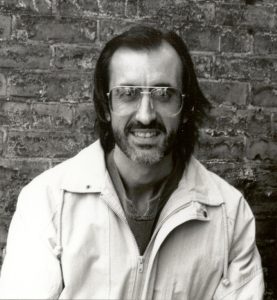
“YOUTH WORKER WANTED: Working in an inner-city Appalachian neighborhood with youth. Must be willing to meet them where they are; in the streets, and in the pool halls.” That’s the job announcement that Jim Holmstrom saw in 1977 that piqued his interest enough to make the call requesting an interview at Santa Maria Community Services. “It was certainly different than any of the other job ads that I saw,” Jim recently recalled. The man on the other end of the phone was Fred Hoeweler, director of Santa Maria’s youth program at that time. A short time later, Jim was hired to a one-year term, beginning August 1 of that year.
Jim is a Cincinnati native who lived most of his life on the westside. After graduating from LaSalle High School, he received a bachelor’s degree in psychology from the University of Cincinnati in 1973 and a master’s degree in social psychology from the University of South Carolina in 1977. He returned home after grad school determined to make a difference on the westside where poverty and crime were major issues.
Jim didn’t know it at that time, but that one-year term would turn out to be the beginning of a 42-year-long journey with Santa Maria and the youth we serve in Lower Price Hill. At that time, the youth program was housed in a small storefront on State Avenue, near Wilder Avenue. It was just a couple of little rooms, with a small bathroom in the back, Jim recalled. The only source of heat was a potbelly stove in the front room. There was one time that Jim burned his shoes on that stove when his feet got too close to the flames.
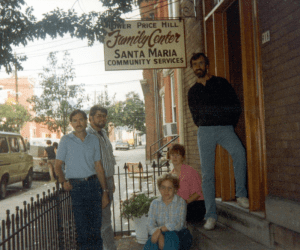
Along with Fred, Jim worked with a youth worker named Dan Daly, an administrative assistant, Pat Ferguson (who later became Pat Mattingly), and another youth worker, Blair Mooney (who would later become Blair Schoen). “Just incredible people, incredible people,” Jim recalled. The youth team, which evolved and changed over the course of Jim’s 42 years of service, made a big impact at several area schools, including Roberts Junior High School, Taft High School, Western Hills High School and especially Oyler School in Lower Price Hill. The latter would refer to the youth team in more recent years as “the dream team,” due to their dedication to the youth they served. Jim ended up making life-long friendships with many of his coworkers.
Jim also recalled many wonderful volunteers who helped the youth program over the years. One name that came up was Joe Williams, whose name is now on the Joe Williams Family Center which currently houses Santa Maria’s youth development program on Glenway Avenue. Jim remembered when Joe began volunteering in the early 1990s. Joe helped with two weekly young men’s meetings, and he has continued to volunteer with the youth program all this time. Jim said, “I know that man’s heart. And, you know, I couldn’t be more pleased that he’s still involved.”
From the very beginning, Santa Maria’s youth program, which used to be called the youth service project, was being sculpted by the youth it served. “We wanted the youth to feel like they had some ownership for the youth service project,” Jim said. “We let the kids paint the walls and they painted them orange and blue and all these crazy colors. What served as a coffee table in the front room was not actually a coffee table. It was one of those big round spools the big cable wire comes on. They painted that orange and blue too.” Those colors are still reflected in Santa Maria’s logo today and our youth development program is still striving to allow youth to be the driving force of the program.
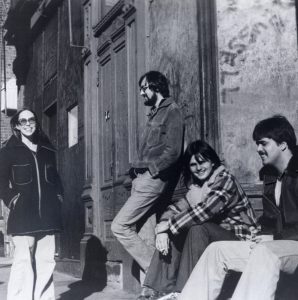
When Jim’s one-year term had concluded in 1978, he started looking for a new job, but Santa Maria executive director at the time, Sister Jane Ellen Shappelle, and associate director, Ted Vittoria, didn’t want to let Jim go that easily. “What they wound up doing was contacting Lower Price Hill businesses and asking for donations to keep me on until they could find more stable funding for me,” he said. “I’ll be forever grateful for that.” And find the funding, they did. Jim’s position eventually became a full-time, permanent position.
When the youth service project began, one of the goals was to reduce juvenile court recidivism rates, something Santa Maria’s co-founder, S. Blandina Segale championed during her many years of service to Santa Maria. She even served as a probation officer for some time. Jim and his colleagues went to juvenile court multiple times a week. “As part of that work, we met the kids, we met their parents, we met their families. We transported – usually the mothers – along with their teenagers – to court,” Jim said.
A lot of Jim’s work was relationship building. He would go out into the Lower Price Hill neighborhood and meet youth where they hung out. “You know, I truly believe after all these years, no matter what your outcomes are that you’re trying to achieve – what your particular performance measures are – that if you build a relationship with the folks, you’re going to have a much better chance to achieve those outcomes,” Jim said.

The most difficult part of Jim’s job was dealing with the loss of life, whether due to drug overdoses, violence in the neighborhood, or other causes. “You know, those are the toughest things to deal with because they really, really hurt a lot,” he said.
Alternatively, he also got to see many families succeed after overcoming really difficult situations. “You essentially do share their hopes, their dreams, their joys, their pain, their triumphs, their disappointments. You know, it’s very humbling to me, and I feel incredibly fortunate and blessed that they felt comfortable enough with me and with our staff to do that,” he said.
In some cases, Jim got to work with multiple generations in the same family. “Some of the kids that I worked with in the past few years, I worked with their parents when their parents were kids in the 90s, and in a number of cases, I worked with their grandparents as kids in the 70s,” Jim recalled.
When Santa Maria celebrated its 100th birthday, The Sisters of Charity of Cincinnati produced a play based on S. Blandina’s book At the End of the Santa Fe Trail. Jim was excited to learn more about S. Blandina who co-founded Santa Maria along with her sister, Justina Segale, also a Sister of Charity. “She didn’t condone the actions of people if they were hurting one another, but she always treated everybody with dignity and respect,” he said of S. Blandina. Sometimes, when faced with a quandary, he would ask himself, “What would S. Blandina do?” He would also say a quick prayer to her in urgent situations.

One such urgent situation happened in 2015 when the youth program was at risk of losing its home in Lower Price Hill. “Please help us to find the solution to continue this work,” he prayed to S. Blandina. And then what Jim called “a series of serendipitous events” happened and the youth development program was able to move into its current home at 2312 Glenway Avenue. “I like to believe that she looks after us,” Jim said.
In March 2020, just before retiring from Santa Maria, Jim was diagnosed with stage three esophageal cancer. Again, he prayed to S. Blandina. He was quickly able to find a great surgeon, get radiation treatments and now there is no evidence of cancer. “I’m doing fine,” he was happy to report. “So far; so good.”
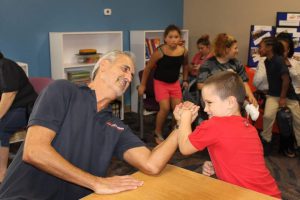
Jim expressed his thanks to anyone who has ever donated to Santa Maria in any way, financially, through volunteering, or serving on the board. “That old cliche about taking a village is so true and all of those roles are part of the village, so thank you for being part of the village and being involved in improving people’s lives,” Jim said. He feels proud to be a member of that village too.
Jim continues serving Santa Maria as a volunteer at the Joe Williams Family Center. “It feels so good to be part of a program that continues to greatly benefit the youth and their families in Lower Price Hill,” he said. “There are so many wonderful programs and dedicated staff, all doing incredible work in the Price Hill Community.”
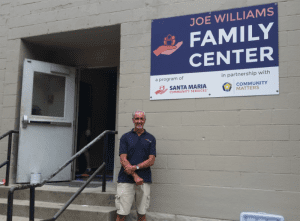
Jim reflected on his time with Santa Maria, “I get great satisfaction in looking back at the work that I and the other staff have done in the community and with community residents.” Jim hopes that Santa Maria continues its mission to help people help themselves long after he’s gone.
